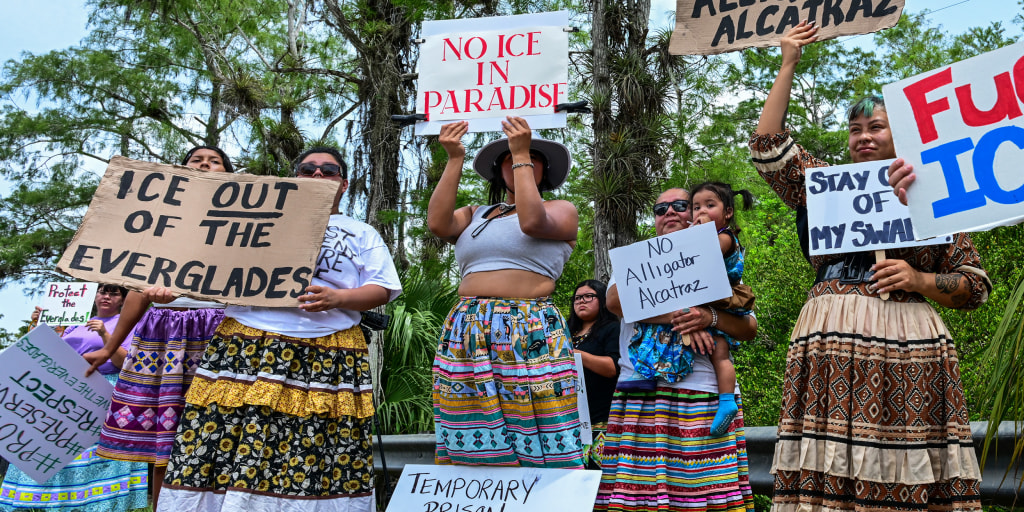Human Rights Violations and Sexual Assault in ICE Detention Centers: A Comprehensive Analysis
There is extensive documentation of human rights violations in U.S. Immigration and Customs Enforcement (ICE) detention centers, including numerous cases of sexual assault committed by guards or facility staff. Below is a detailed overview of the available evidence, the procedures intended to prevent abuse, and the degree to which these procedures are being followed in practice.
I. Documented Reports of Sexual Assault and Abuse
Multiple independent sources—ranging from human rights organizations to government oversight agencies and investigative media—have chronicled widespread allegations of sexual assault and related abuses in ICE facilities.
Prevalence of Allegations
-
Between 2010 and 2016, the Department of Homeland Security’s (DHS) Office of Inspector General (OIG) received over 33,000 complaints of sexual or physical abuse. Of these, approximately 44.4% (around 14,700) were related to ICE facilities—more than any other DHS component. Fewer than 1% were formally investigated.
POGO -
A 2010 Human Rights Watch report documented sexual assault and harassment at the T. Don Hutto Residential Center in Texas, where a guard was arrested for groping women detainees.
Human Rights Watch -
In 2020, a formal complaint alleged that guards at the El Paso Service Processing Center sexually assaulted multiple detainees in surveillance blind spots, with one lawyer stating that victims were told no one would believe them.
ProPublica -
A 2024 ACLU report on California ICE facilities revealed patterns of inappropriate pat-downs that were described as sexually abusive, with retaliation against those who spoke up.
ACLU Northern California -
A 2025 Amnesty International investigation again flagged El Paso for systemic abuse, including physical beatings and verbal degradation by guards.
El Paso Matters -
A peer-reviewed 2024 study of ICE incident reports from 2018 to 2022 found stable but consistently high levels of sexual assault reports, with an uptick in allegations involving facility staff. However, substantiation rates remained extremely low, likely due to fear of retaliation and lack of access to proper reporting mechanisms.
PMC Study -
A 2024 complaint from the Central Louisiana ICE Processing Center detailed an incident of sexual assault followed by retaliatory solitary confinement.
RFK Human Rights -
In June 2025, several 911 calls originating from ICE detention facilities were released, describing sexual assaults by staff against detainees.
At-Risk Populations
-
Transgender individuals, particularly transgender women, are disproportionately affected. A 2013 GAO report noted that nearly two-thirds of substantiated sexual assault cases involving trans individuals were committed by guards.
American Progress -
Language barriers prevent many detainees from reporting abuse or understanding their rights. For example, the South Texas Family Residential Center has faced criticism for failing to provide adequate translation services.
POGO
Retaliation and Underreporting
-
Retaliation is common and includes solitary confinement, deportation threats, or relocation. A woman in York County Jail (PA) was placed in solitary for 11 days after filing a harassment complaint.
Freedom for Immigrants -
Many cases go unreported due to fear, lack of legal literacy, language barriers, and perceived futility of filing grievances.
PMC Study
Systemic and Structural Problems
-
Privately-run facilities (e.g., GEO Group, CoreCivic) have a higher incidence of complaints. These companies operate 86% of ICE detention beds as of 2025.
TRAC Reports -
Oversight agencies like CRCL and OIG have issued recommendations often ignored by ICE and facility operators.
POGO
II. Existing Procedures and Legal Framework
The ICE detention system is legally bound to follow the Prison Rape Elimination Act (PREA) of 2003 and its own Performance-Based National Detention Standards (PBNDS). These outline procedures for preventing, reporting, and investigating sexual abuse.
1. Reporting Mechanisms
-
Detainees may report abuse via written or verbal complaints to facility staff, ICE headquarters, DHS OIG, or anonymous hotlines such as DRIL.
-
The ICE Detainee Handbook is supposed to inform detainees of their rights, though studies find it often lacks clarity.
Human Rights Watch
2. Investigative Protocols
-
Allegations must be logged in electronic systems and reviewed. Third-party monitors are meant to ensure compliance.
-
DHS OIG or CRCL can escalate severe cases to prosecutors, though only a small fraction reach this level.
ProPublica
3. Oversight Structures
-
Oversight is distributed among ICE, OIG, CRCL, and the Office of Immigration Detention Ombudsman (OIDO).
-
Facilities must follow a version of the PBNDS or NDS (2008, 2011, or 2019). However, these standards are often unenforceable and rarely result in sanctions.
American Immigration Council
4. Preventive Measures
-
PREA-mandated training for staff is required, but compliance is spotty.
-
ICE’s Detention Monitoring Council includes a subcommittee on sexual violence, though its impact remains limited.
III. Are These Procedures Being Followed?
The evidence strongly suggests that existing procedures are poorly implemented and routinely disregarded, especially in private facilities.
Inadequate Investigations
-
Of 33,000+ abuse complaints (2010–2016), <1% were investigated.
-
A 2018 ICE report found that out of 374 sexual assault allegations, only 48 were substantiated, highlighting low follow-through rates.
Routine Non-Compliance
-
CRCL found repeated violations of PREA and PBNDS at facilities like Karnes County Residential Center (2014–2016).
-
Facilities lack consequences for non-compliance, and standards are contractually required but not legally binding.
Retaliation Remains Pervasive
-
From York County (PA) to Bergen County (NJ), detainees report being punished for filing abuse complaints—often with solitary confinement or deportation threats.
Oversight Lapses
-
Inspectors have documented falsified compliance reports, ignored CRCL recommendations, and lack of enforcement by DHS.
Urban Institute
Private Facility Risks
-
The profit motive in privately-run centers often incentivizes underreporting, understaffing, and neglect, worsening conditions for detainees.
IV. Critical Analysis
Despite PREA and PBNDS providing a framework for accountability, structural weaknesses, profit-driven management, fear among detainees, and weak federal oversight create conditions where abuse can persist unchecked.
-
Underreporting and low substantiation rates obscure the true scale of abuse.
-
Detainees with limited English or legal resources are especially at risk.
-
Independent watchdogs, human rights groups, and whistleblowers report being ignored or blocked from facilities.
Human rights organizations—including the ACLU, Freedom for Immigrants, and Human Rights Watch—continue to call for:
-
Independent, enforceable oversight mechanisms
-
The end of private ICE detention contracts
-
Reduced use of detention in favor of community-based alternatives
V. Conclusion
Sexual assault and abuse in ICE detention facilities are well-documented, ongoing, and often unpunished. The procedures in place—while adequate in design—are rarely enforced in practice due to systemic oversight failures, fear of retaliation, and lack of legal accountability. Women, LGBTQ+ detainees, and non-English speakers remain the most vulnerable.
Until ICE’s enforcement structures are made truly independent, and private facilities are either reformed or phased out, these abuses are likely to continue.
For further information or to report abuse, visit www.ice.gov or www.dhs.gov.
Let's refer to the Stanford Prison Experiment conducted by psychologist Philip Zimbardo in 1971. In this infamous study, participants were randomly assigned roles of “guard” or “prisoner” in a simulated prison environment. The experiment had to be shut down early because the "guards" quickly began abusing their power, inflicting psychological and physical harm on the "prisoners" — even though everyone knew it was just a roleplay. The key insight: unchecked power, dehumanization, and institutional structure can rapidly turn ordinary people into perpetrators of cruelty.
ICE Detention and the Stanford Prison Experiment: A System of Dehumanization and Asymmetric Power
To truly grasp the systemic abuse taking place in ICE detention centers, we must understand it through the lens of the Stanford Prison Experiment — a psychological study that demonstrated how ordinary people, given authority and impunity, can rapidly become abusive toward those they perceive as powerless.
In ICE facilities across the United States, guards and staff operate in unaccountable, highly surveilled, dehumanizing environments, where the detained population — overwhelmingly people of color, many without legal representation — are subjected to conditions that reflect the worst instincts of unchecked authority.
From Simulation to Reality: A Stanford Experiment on a National Scale
In Zimbardo’s experiment, abuse didn’t emerge from individual sadism — it was structural. Guards abused prisoners because the system gave them permission, authority, and no accountability. That same dynamic is at play in ICE facilities:
-
Guards control every aspect of detainees’ lives, from meals and showers to when they can call family or see a lawyer.
-
Abuse, sexual assault, and retaliation happen not in spite of the system, but because the structure allows and even rewards such behavior.
-
The lack of oversight, independent accountability, or legal consequences creates a perfect psychological storm: guards dehumanize detainees, and detainees are stripped of agency.
Just like the guards in the Stanford experiment, ICE personnel become products of their environment — one that normalizes cruelty, isolates victims, and insulates perpetrators from consequences.
Statelessness as Structural Violence
Many detainees are not just undocumented — they are being pushed into a kind of statelessness, which international law recognizes as a severe human rights violation.
-
They cannot safely return home, yet they have no path to legal status in the U.S.
-
Bureaucratic hurdles, missing documentation, and prolonged detention create a legal limbo where they effectively have no country, no rights, and no recourse.
-
Stateless people are denied the protections of nationality, making them uniquely vulnerable to abuse, exploitation, and indefinite confinement.
In effect, the system does not merely detain; it erases identity.
Massive Surveillance + No Rights = Asymmetric Tyranny
Today’s ICE regime is not just physical — it is digital and predictive, powered by Palantir-like tech and surveillance tools that map, predict, and track “undocumented” people:
-
Biometric databases, predictive risk algorithms, and license plate readers feed into an ecosystem of total surveillance.
-
These tools are wielded not against criminals, but against workers, families, caregivers, and asylum seekers.
-
People without papers are being hunted by machine-enhanced state power, not because they pose a threat, but because they exist outside a rigid, paper-based legal system.
This creates a profound asymmetry of power: on one side, a hyper-networked surveillance apparatus; on the other, individuals with no rights, no counsel, and no way to contest the data-driven logic of their capture.
Essential Labor, Disposable Lives
Many detainees perform critical work in U.S. society: farm labor, domestic care, food processing. During the pandemic, they were deemed essential — yet today, they are treated as expendable.
The contradiction is staggering:
-
We rely on their labor, yet deny them basic dignity.
-
They build and sustain our economy, yet are targeted and caged.
-
They are punished for lacking papers — the very documents that migrant workers in the Gulf states receive through structured, though often exploitative, systems.
What differentiates these detainees from “legal” foreign workers is not morality, threat, or value — but paperwork. That’s it. And for that, they are subjected to isolation, abuse, and indefinite detention.
Conclusion: The System Is the Cruelty
ICE detention, when viewed through the Stanford Prison Experiment lens, reveals a grim truth: people don’t become abusive because they are evil — they become abusive because the system permits, encourages, and protects that abuse.
Coupled with:
-
a state-induced statelessness,
-
predictive surveillance technology,
-
and the criminalization of essential workers,
...this is not just a broken system — it is a machine of dehumanization. It institutionalizes cruelty under the guise of immigration enforcement and turns the most vulnerable into targets of an increasingly militarized bureaucracy.
The answer isn’t just reform. It’s reimagining the system — reducing reliance on detention, restoring legal pathways, imposing external oversight, and recognizing the full humanity of every person, regardless of their status.
🧵 What if I told you ICE detention is the real-life Stanford Prison Experiment — but with AI surveillance, stateless detainees, and zero accountability?
— Paramendra Kumar Bhagat (@paramendra) July 2, 2025
This isn’t immigration enforcement. It’s institutionalized cruelty.
Let’s break it down: ⤵️
Deported (novel) https://t.co/KrjKa39Kon
— Paramendra Kumar Bhagat (@paramendra) July 2, 2025
Empty Country (novel) https://t.co/yMDHpkDqEA
— Paramendra Kumar Bhagat (@paramendra) July 2, 2025
Trump’s Default: The Mist Of Empire (novel) https://t.co/33eFTUwu2V
— Paramendra Kumar Bhagat (@paramendra) July 2, 2025
Poetry Thursdays (novel) https://t.co/Geni1KBKD2
— Paramendra Kumar Bhagat (@paramendra) July 2, 2025



